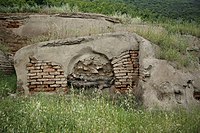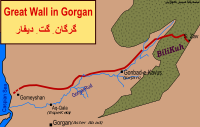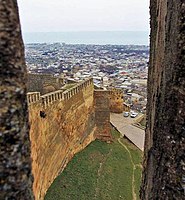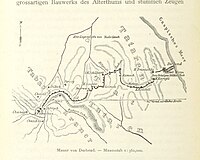User:HistoryofIran/Khosrow I
| This is a Wikipedia user page. This is not an encyclopedia article or the talk page for an encyclopedia article. If you find this page on any site other than Wikipedia, you are viewing a mirror site. Be aware that the page may be outdated and that the user in whose space this page is located may have no personal affiliation with any site other than Wikipedia. The original page is located at http://en.wikipedia.org/wiki/User:HistoryofIran/Khosrow_I. |
| Khosrow I 𐭧𐭥𐭮𐭫𐭥𐭣𐭩 | |
|---|---|
| King of Kings of Iranians and non-Iranians | |
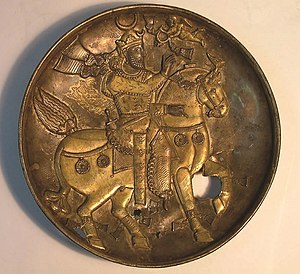 Plate depicting Khosrow I. | |
| Shahanshah of the Sasanian Empire | |
| Reign | 13 September 531 – February 579 |
| Predecessor | Kavad I |
| Successor | Hormizd IV |
| Born | 512–514 Ardestan |
| Died | February 579 (aged 65-67) Ctesiphon |
| Spouse | Khazar princess |
| Issue | Hormizd IV Anushzad Yazdandar |
| House | House of Sasan |
| Father | Kavad I |
| Mother | Ispahbudhan noblewoman |
| Religion | Zoroastrianism |
Khosrow I (also spelled Khosrau, Khusro or Husraw; Middle Persian: 𐭧𐭥𐭮𐭫𐭥𐭣𐭩; New Persian: خسرو), traditionally known by his epithet of Anushirvan ("the Immortal Soul"), was Sasanian King of Kings of Iran from 531 to 579. He was the son and successor of Kavad I (r. 488–496, 498–531). His mother was a unnamed noblewoman from the Ispahbudhan clan.
Khosrow was known for his character, virtues, and knowledge. During his ambitious reign, he continued his father's project of making major reforms in the social, military, and economic aspects of the empire, increasing the welfare and the revenues, establishing a professional army, and founding or rebuilding many cities, palaces, and infrastructures. These reforms and changes would outlive the empire itself, serving as a model for kings and caliphs and sultans alike. Khosrow was interested in literature and philosophy, and under his reign, art and science flourished in Iran.
Khosrow's reign is furthermore marked by initial internal conflicts and campaigns against the Sasanians' neighboring archrivals, the Hephthalites in the east, the Aksumites in the south, and the Byzantine Empire in the west—in particular the Lazic War and the war of 572–591. He was generally successful in his wars, being admired for defeating the Byzantine Empire and restoring Sasanian dominance in the western part of South Asia. Khosrow was the most distinguished of the Sasanian kings, and his name became, like that of Caesar in the history of Rome, a designation of the Sasanian kings. Due to his accomplishments, he has been hailed as the new Cyrus.
At the time of his death, the Sasanian Empire had reached its greatest extent since Shapur II, stretching from Yemen in the west to Gandhara in the east. He was succeeded by his son Hormizd IV.
Name and titles
[edit]"Khosrow" is the New Persian variant of his name used by scholars; his original name was Middle Persian, Husraw, itself derived from Avestan Haosrauuah ("he who has good fame").[1] The name is transliterated in Greek as Chosroes and in Arabic as Kisra.[2] Besides his personal name, he is widely known in sources by his epithet of Anushirvan ("the Immortal Soul"), a New Persian rendering of Middle Persian anūšag-ruwān.[3] Other variants of the name are Anoshirvan,[2] Anushiravan[4] and Nowshīrvān.[5] Another epithet Khosrow was known by was Dadgar ("Dispenser of Justice").[6]
Historiography
[edit]Many sources dating to the Islamic era, such as al-Tabari's Arabic History of Prophets and Kings and the Shahnameh ("Book of Kings") of the medieval Persian epic of Ferdowsi (d. 1020), give much information regarding Khosrow's reforms, and thus most likely drew both of their information from the Middle Persian history book Khwaday-Namag ("Book of Lords").[2] Other works were made independently, such as the Sirat Anushirwan, which was reportedly an autobiography made by Khosrow himself, and survives in the work of Miskawayh (932–1030).[2] Khosrow is also mentioned in several Greek sources, such as the ones of Procopius, Agathias and Menander Protector, who all give important information regarding Khosrow's management of the Irano-Roman wars.[2] Syriac authors, such as John of Ephesus and Zacharias Rhetor also include Khosrow in their work, offering a perception of the consequences that his expeditions brought on the people who lived on the Roman border.[2]
Background
[edit]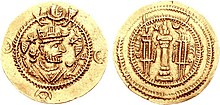
Khosrow I was reportedly born between 512 and 514 at Ardestan, a town located in the Spahan province in central Iran.[7][8] The town, dating back to the Achaemenid period, thrived during Khosrow's age, and also included a fire temple, which was said to be founded by the mythological Kayanian king Kay Bahman,[7] whom the Sasanians claimed ancestry from.[9] Khosrow was the youngest son of Kavad I, the ruling Sasanian shah.[10] His mother was an Ispahbudhan princess, who was the sister of the leading Iranian general Bawi.[11] The Ispahbudhan were one of the Seven Great Houses of Iran that formed the elite aristocracy of the Sasanian Empire. They in particular enjoyed such a high status that they were acknowledged as "kin and partners of the Sasanians".[12] The family also held the important position of spahbed of the West, i.e. the Sasanian Empire's southwestern regions (Khwarwaran).[13]
Following the tradition of the aristocratic or upper-class families, Khosrow would have started at school (frahangestān) between the age of five and seven.[14] There he would learn to write and would learn the yashts, Hadokht, Bayān Yasn and Vendidad, following the same pattern of schooling made for a future priest (herbed).[14] Furthermore, he would observe the Middle Persian translation of the Avesta, the Zend.[14] Afterwards, he was schooled in riding, archery, polo (chovgan) and military creativity.[14]
Early life
[edit]Negotiations with the Byzantines over the adoption of Khosrow
[edit]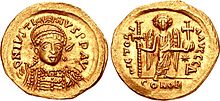
In c. 520, Kavad, in order to secure the succession of Khosrow, whose position was threatened by rival brothers and the Mazdakite sect, proposed that Emperor Justin I adopt him. The proposal was initially greeted with enthusiasm by the Byzantine Emperor and his nephew, Justinian, but Justin's quaestor, Proclus, opposed the move, due to the concern of Khosrow possibly later try to take over the Byzantine throne.[10] The Byzantines instead made a counter-proposal to adopt Khosrow not as a Roman, but a barbarian.[15] In the end the negotiations did not come to a consensus.[10] Khosrow reportedly felt insulted by the Byzantines, and his attitude deteriorated towards them.[10]
Mahbod, who had along with Siyawush acted as the diplomats of the negotiations, accused the latter of purposely sabotaging the negotiations.[15] Further accusations were made towards Siyawush, which included the reverence of new deities and having his dead wife buried, which was a violation of Iranian laws.[10] Siyawush was thus most likely a Mazdakite, the religious sect that Kavad originally supported but now had withdrawn his support from. Although Siyawush was a close friend of Kavad and had helped him escape from imprisonment, the latter did not try to prevent his execution, seemingly with the purpose of restricting Siyawush's immense authority as the head of the Sasanian army, a post which was disliked by the other nobles.[10] Siyawush was executed, and his office was abolished.[16] Despite the breakdown of the negotiations, it was not until 530 that full-scale warfare on the main eastern frontier broke out. In the intervening years, the two sides preferred to wage war by proxy, through Arab allies in the south and Huns in the north.[17]
Persecution of Mazdak and his followers
[edit]Mazdak was the name of a chief representative of a religious and philosophical teaching called Mazdakism, which opposed violence, and called for the sharing of wealth, women and property,[18] an archaic form of communism.[19] Mazdakism not only consisted of theological and cosmological aspects, but also political and social impacts, which was to the disadvantage of the nobility and clergy. Kavad had originally used the faith as a political tool in order to curb the power of the nobility and clergy.[19][18] Kavad's plan succeeded, weakening the nobility and clergy, thus opening the way to be able to make reforms with less difficulty.[10][20] With the reforms roaring by the 520s, Kavad no longer had use of Mazdak.[21] As a result, he officially withdrew his support from the Mazdakites.[10] A debate was arranged, where not only the Zoroastrian priesthood, but also the Christian and Jewish ones slandered Mazdak and his followers.[21]
According to the Shahnameh ("The Book of Kings"), written several centuries later by the medieval Persian poet Ferdowsi, Kavad had Mazdak and his supporters sent to Khosrow, who had his supporters killed by burying their heads in a walled orchard, with only their feet being visible.[21] Khosrow then summoned Mazdak to look at his garden, saying the following; "You will find trees there that no-one has ever seen and no-one ever heard of even from the mouth of the ancient sages."[21] Mazdak, seeing his followers corpses, screamed and passed out. He was afterwards executed by Khosrow, who had his feet fastened on a gallows, and had his men shoot arrows at him.[21] The validity of the story is uncertain; Ferdowsi used much earlier reports of events to write the Shahnameh, and thus the story may report some form of contemporary memory.[22]
Accession
[edit]The Eternal Peace of 532
[edit]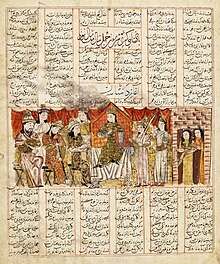
In 531, while the Iranian army was besieging Martyropolis, Kavad became ill and died.[23] Khosrow succeeded him, but due to his domestic position being insecure, he wanted to make peace with the Byzantines, who themselves under Emperor Justinian I (r. 527–565) were perhaps already more focused on recovering the lost western half of the Roman Empire than in pursuing war against Iran.[24] The Byzantine envoys Rufinus, Hermogenes, Alexander and Thomas found Khosrow in a more conciliatory disposition than his father, and an agreement was soon reached. Justinian would pay 110 centenaria (11,000 pounds) of gold, ostensibly as a contribution to the defence of the Caucasus passes against the barbarians living beyond, and the base of the dux Mesopotamiae would be withdrawn from the fortress of Dara to the city of Constantina. The two rulers would recognize once again each other as equal and pledged mutual assistance.[24][25] Khosrow initially refused to hand back the two Lazic forts, while demanding the return of the two other forts the Byzantines had captured in Sasanian Armenia. Justinian at first agreed, but soon changed his mind, causing the agreement to be broken off.[26] In summer 532, however, a new embassy by Hermogenes and Rufinus managed to persuade Khosrow for a full exchange of the occupied forts, as well as for allowing the exiled Iberian rebels to either remain in the Byzantine Empire or return safely to their homes.[26]
Consolidation of power
[edit]Sometime during the early reign of Khosrow, he had to deal with his eldest brother Kawus, who ruled as governor-king of the northern province of Padishkhwargar.[27] Unlike Khosrow, he was a Mazdakite (or at least had strong Mazdakite sympathies), and thus had their support as the candidate for the throne.[28] Kawus asserted to be the legitimate heir of the throne due to his older age.[28] He was, however, defeated by Khosrow's forces and taken to Ctesiphon, where Khosrow summoned the priests and urged Kawus to make confessions and ask for forgiveness, so that he could be released.[29] Kawus refused, preferring death, forcing Khosrow to have him killed.[29] Khosrow reportedly "cursed the fortunes" for "forcing him to kill a brother like Kawus."[29]
Another danger to Khosrow's rule was that of his uncle Bawi, who along with other members of the Iranian aristocracy, became involved in a conspiracy in which they tried to overthrow Khosrow and make Kavad, the son of Khosrow's brother Jamasp, the shah of Iran.[30] Upon learning of the plot, Khosrow executed all his brothers and their offspring, along with Bawi and the other aristocrats who were involved.[30] Khosrow also ordered the execution of Kavad, who was still a child, and was away from the court, being raised by Adergoudounbades. Khosrow sent orders to kill Kavad, but Adergoudounbades disobeyed and brought him up in secret, until he was betrayed to the shah in 541 by his own son, Bahram. Khosrow had him executed, but Kavad, or someone claiming to be him, managed to flee to the Byzantine Empire.[31]
Military campaigns
[edit]War with the Byzantine Empire, 540–562
[edit]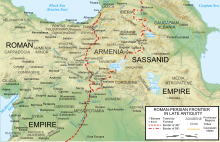
In 539 Khosrow had originally attempted to gain a casus belli against the Byzantines by trying to take advantage of a disagreement between his Lakhmid clients and the Byzantine clients Ghassanids, who both claimed ownership of the lands south of Palmyra, near the old Strata Diocletiana.[32] His attempt was, however, thwarted when the Byzantines successfully equivocated the problem.[33] Subsequently, Khosrow accused of Justinian trying to bribe the Lakhmid ruler al-Mundhir III ibn al-Nu'man (r. 503–554) through his diplomat Summus, and also that he had heartened some Huns to make incursions into Iran.[33] The Ghassanid ruler al-Harith ibn Jabalah (r. 528–569) invaded Mundhir's territory and carried off rich booty.[33] Khosrow complained to Justinian about this incident, and requested that the stolen riches be returned to him, including payment for the Arabs that had been killed during the attack.[34] His request was, however, ignored.[35] This incident, along with the support by an emissary from the Ostrogoth king Vitiges, and the Armenians living in Byzantine territory being dissatisfied with their rule, encouraged Khosrow to renew the war against the Byzantines.[34] Justinian's ceaseless wars in North Africa and Italy must have contributed to Khosrow's aspirations as well.[33] Justinian, informed of Khosrow's intention for war, tried to dissuade him, but to no avail.[35]
In May 540, Khosrow invaded the domains of the Byzantines; he avoided the fortress of Circesium, and instead approached Zenobia, where he made a lukewarm attempt to persuade the fortress to surrender, which proved unsuccessful.[35] He then proceeded to Sura and killed its commander Arsaces in battle. Demoralized by the death of their commander, the residents sent their bishop to parley with Khosrow.[35] Feigning to accept the plea of the bishop, Khosrow took advantage of the occasion and captured the city, which was shortly sacked.[35] Germanus, the cousin of Justinian, sent the bishop of Beroea, Megas, to negotiate with Khosrow.[35] Regardless, Khosrow continued his expedition, threatening the city of Hierapolis, whose custodians swiftly paid him 2,000 pounds or 910 kilograms of silver to leave the city untouched.[35] After receiving additional ples by Megas, Khosrow agreed to end his expedition in return of ten centenaria.[35] While Megas went back to Antioch to inform Germanus of Khosrow's demands, the latter approached Beroea, which he had sacked.[35] In June, he reached Antioch, where he offered its citizens to not attack the city in return for ten centenaria. His offer was rejected, and as a result he captured and sacked the city.[36]
Justinian sued for peace, and made a treaty with Khosrow that the Iranians would withdraw back to their domains in return for a payment of 50 centenaria plus 5 centenaria extra each year.[37] Part of treaty also included that the Byzantine envoys were to be hostages of Khosrow as an assurance that the Byzantines would honor the agreement.[37] However, before departing, Khosrow went to the port of Antioch, Seleucia, where he bathed in the Mediterranean Sea.[37] He then told the envoys that he wished to the city of Apamea out of interest, which they reluctantly allowed him, with the condition that he would leave for his domains afterwards.[38] There he held chariot races, where he made the Blue Faction—which was supported by Justinian—lose against the rival Greens.[38] Khosrow extracted tribute from Apamea and other Byzantine towns, at which point Justinian called off his truce and prepared to send his commander Belisarius to move against the Sasanians.[39]
War in the east
[edit]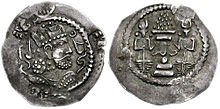
With a stable peace agreement with the Byzantines in the west, Khosrow was now able to focus his attention on the eastern Hephthalites[40] and end their domination over Central Asia.[41] Even with the growth of Sasanian military power under Khosrow's reforms, the Sasanians were still uneasy at the prospect of attacking the Hephthalite on their own and began to seek allies.[40] Their answer came in the form of Turkic incursions into Central Asia.[42] The movement of Turkic people into Central Asia very quickly made them natural enemies and competitors to the Hephthalites.[40]
The Hephthalites were a strong military power but they lacked the organization to fight on multiple fronts.[40] The Sasanians and the Western Turkic Khaganate made an alliance and in 557 launched a two pronged attack on the Hephthalites, taking advantage of their disorganization and disunity. The Hephthalite Empire was destroyed after the battle of Gol-Zarriun, and broke into several minor kingdoms around the Oxus. The Hephthalite king Ghadfar and what was left of his men fled southward to Sasanian territory, where they took refuge.[43] Meanwhile, the Turkic Khagan Sinjibu reached an agreement with the Hephthalite nobility, and appointed Faghanish, the ruler of Chaghaniyan, as the new Hephthalite king.[44]
This was much to the dislike of Khosrow, who considered the Turkic collaboration with the Hephthalites to pose a danger for his rule in the east, and thus marched towards the Sasanian-Turkic border in Gurgan. When he reached the place, he was met by a Turkic delegate of Sinjibu that presented him gifts.[44] There Khosrow asserted his authority and military potency, and persuaded the Turks to make an alliance with him. The alliance contained a treaty that made it obligatory for Faghanish to be sent to the Sasanian court in Ctesiphon and gain the approval of Khosrow for his status as Hephthalite king.[44] Faghanish and his kingdom of Chaghaniyan thus became a vassal of the Sasanian Empire, which set the Oxus as the eastern frontier the Sasanians and Turks.[45][46]
In 568 a Turkic embassy was sent to Byzantine to propose an alliance and two pronged attack on the Sasanian Empire. Fortunately for the Sasanians, nothing ever came from this proposal.[47] Later in 569/570, Sinjibu attacked and pillaged Sasanian border lands, but a treaty was soon signed.[41] Khosrow then sent a Mihranid named Mihransitad, to estimate the quality of the daughter of the Turkic Khagan.[48] According to Armenian sources her name was Kayen,[49] while Persian sources states that her name was Qaqim-khaqan.[50] After Mihransitad's visit in Central Asia, Khosrow married Qaqim-khaqan. According to some sources, Hormizd IV, the successor of Khosrow, was the son of the Turkic princess. However, Encyclopædia Iranica states that the "marriage with the daughter of the Turkic khaqan is chronologically impossible", and says that Hormizd was born in 540, thirty years before Khosrow's marriage.[41] In conclusion, with the fragment of the Hephthalite state, Chaghaniyan, Tukharistan, Kabulistan, Zabulistan and Gandhara were now under Sasanian control.[51]
Conquest in Yemen
[edit]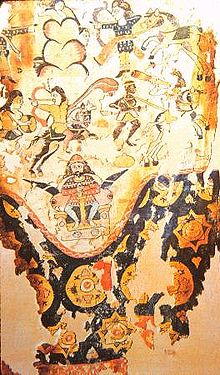
War with the Byzantine Empire, 572–579
[edit]Reforms
[edit]Khosrow continued the reforms started by his father.[52] A new tax reform was implemented, a poll tax was created, and a examination of taxable land was made in order to make sure that the taxation was fair.[21] The empire was divided into four frontier regions, with a military commander (spahbed) in charge of each district, whilst a chancery was also added to keep the soldiers equipped.[21] Before the reforms of Kavad and Khosrow, the general of the Iranians (Eran-spahbed) managed the army of the whole empire.[53]
Furthermore, a new priestly office was also created named "advocate and judge of the poor" (driyōšān jādag-gōw ud dādwar), which assisted the clergy to help the poor and underprivileged (an obligation they had possibly ignored previously).[54][21] The power of the dehqan, a class of small land-owning magnates, substantially increased (and possibly even led to their establishment in the first place).[21] They became the backbone of his economic reforms and had also played a key role in suppressing the Mazdakites.[2] He also enrolled different tribal groups into his army, such as the Daylamites.[55] This was done in order to create a military whose loyalty was more drawn towards the shah.[55] It was due to these reforms and Khosrow's just conduct, that he was given the epithet of Dadgar ("Dispenser of Justice").[2]
Philosopher King
[edit]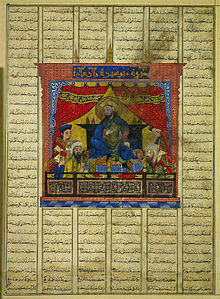
Not only did Middle Persian literature prosper under Khosrow, but also translations from Syriac, Greek, and Indian chronicles on science, especially medicine and astronomy.[56] Khosrow's curiosity in history resulted in a collection of an official "national history", the Khwaday-Namag ("Book of Lords").[56] His court astronomers assembled the "Royal Canon" (Zij-i šahriārān), which subsequently was used as the primary for astronomers and chronographers in Sasanian Iran and the later Muslim world.[56] Khosrow's philosophical thoughts had led to the formation of a nation interested in foreign ideas and argumentations.[56]
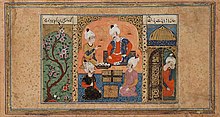
Khosrow is known for saying a philosophic quote that follows:
| “ | We examined the customs of our forebears, but, concerned with the discovery of the truth, we [also] studied the customs and conducts of the Romans and Indians and accepted those among them which seemed reasonable and praiseworthy, not merely likeable. We have not rejected anyone because they belonged to a different religion or people. And having examined “the good customs and laws of our ancestors as well as those of the foreigners, we have not declined to adopt anything which was good nor to avoid anything which was bad. Affection for our forebears did not lead us to accept customs which were not good.[56] | ” |
Academy of Gundeshapur
[edit]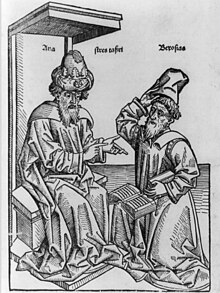
Khosrow I is known to have greatly expanded the Academy of Gundeshapur, located in the city of Gundeshapur.[51]
Religious policy
[edit]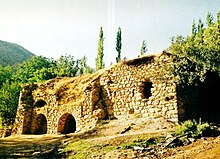
Khosrow, like all other Sasanian rulers, was an adherent of Zoroastrianism.[57] Since the 5th century, the Sasanian monarchs had been made aware of the significance of the religious minorities in the realm, and as a result tried to homogenize them into a structure of administration where according to legal principles, all would be treated straightforwardly as mard / zan ī šahr, i.e. "man/woman citizen (of the Empire)."[58] Jews and notably Christians had accepted the concept of Iran and considered themselves part of the nation.[58] By the time of Khosrow, the leader of the Church of the East had the title of "Catholicos of Iran" (Ērān Catholics).[59]
Sasanian monarchs only persecuted other religions when it was in their urgent political interests to do.[60] This also applied to Khosrow, who, in the words of Eberhard Sauer, had to "walk a fine line".[60] Khosrow himself used the church considerably, and was fond of its Patriarch, Aba I, whom he wanted to defend against the Zoroastrian priests.[60] Nevertheless, Aba was accused of working with the Byzantines, which was a serious allegation due to the war that had begun in 540.[60] Consequently, in 542, Aba was dismissed from his post, but was only exiled instead of being executed.[60]
Khosrow even enjoyed good relations with Gregory, the Mihranid commander of the Iranian troops in the Caucasus, who had showily disowned Zoroastrianism in front of other troops massed at a feast in 518.[61] This resulted in discontent amongst members of the court, who pressured Khosrow to deal with an apostate from such a powerful and influential family, stating that "It is a great dishonor for the religion of the Magians that such a great man from the lineage of the house of Mihran, who have always been servants of Ohrmazd, now becomes a servant of Christ."[62] Khosrow was thus forced to have Gregory relieved and incarcerated, yet the Mihranids demeed Khosrow's choice insufficient.[62] A son of Gregory's paternal uncle, Mihran, asked Khosrow to execute Gregory for "bringing dishonor to our lineage."[62] The latter was in a good position to make such request, due to recently having defeated the Hephthalites in the east; Gregory was eventually executed.[62]
Khosrow did however deal harshly and swiftly with people with of any belief or practice that ran contrary to Sasanian-mediated Zoroastrian orthodoxy.[63] Aberrance in ceremony and principle exceeded apostasy as "a social and political evil in undermining the foundations of the imperial religion (Payne)."[64] According to Khosrow's supposed autobiographical work of Sirat Anushirwan, he had a party of nobles practicing unorthodoxy executed instantly when he found out about them.[64] According to the book, Khosrow also had another group−supposedly Manichaeans−banished from Iran.[64] This was due to the royal anxieties regarding the chance of religious rogues to upset the political structure, which had recently occurred during Kavad and Khosrow's reigns by the Mazdakites.[64]
Constructions
[edit]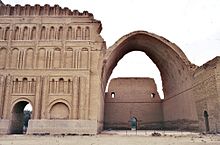
Khosrow is known to have ordered many public works projects during his long reign, such bridges, roads, dams and walls.[51] To protect the frontiers of Iran, Khosrow had a sequence of walls built (and fortified) around his empire, much like the Great Wall of China and Hadrian's Wall in Northern England.[65] Instead of constructing it on one side of the empire, he had it on four.[66] According to Middle Persian sources, Khosrow I ordered the construction of the Great Wall of Gorgan, which extended from the eastern coast of the Caspian Sea to block incursions by nomadic tribes, such as the Hephthalites.[65] In the northwest, he had the Derbent Wall further fortified to protect the area from incursions by Alans, Turks, Sarirs, Khazars, and other northern neighbours.[67]
Another wall was constructed in the southwest, called the war-i tāzigān ("wall of the Arabs").[66] He may have also built another wall in the northeast−the Wall of Tammisha.[68] Besides defense structures, Khosrow also had a large-scale canal system created in Asoristan, known in Islamic sources as the Nahrawan Canal.[69] Out of all his constructions, his most memorable and noteworthy achievement was the palace he had made at Ctesiphon, known as the Taq-e Kasra.[51] The palace, still standing till this day, albeit heavily ruined, portrays one of the empire's most remarkable architectural accomplishments.[2]
After the sack of Antioch in 540, Khosrow built a new city one parasang (4–5 kilometres or 2.5–3.1 miles) south of Ctesiphon for the inhabitants he had captured.[70] It was located on the eastern bank of the Tigris, and was officially named Weh-andīōg-husraw ("City Better than Antioch [has] Khosrow [built this]" or "Khosrow's Better Antioch").[71] The city reportedly had public baths and a hippodrome, and a street program modelled on Antioch.[72] The Christian population was granted freedom of religion and burial.[72] The city was known informally as Rumagan ("Town of the Greeks"), which later became ar-Rumiyya under the Caliphate.[72] The remains of the city are most likely situated at the unexcavated place that is still till this day known as Bustan Kisra ("Gardens of Khosrow").[72]
-
Remains of the Great Wall of Gorgan.
-
Map illustrating the extent of the Great Wall of Gorgan.
-
Wall of the Derbent citadel.
-
Map of the Sasanian fortifications at Derbent, by Roderich von Erckert.
Coinage
[edit]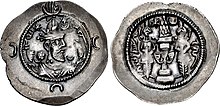
The Sassanian revival took place under his rule, so Khosrow minted such inscriptions on his especial issue coinage as "Iranians has become fearless" (ērān abē-bēm kard), and "Iranians became strong" (ērān abzonhēnēd).[73]
Legacy
[edit]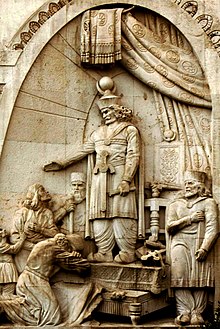
Nöldeke states that Khosrow was "certainly one of the most efficient and best kings that the Iranians have ever had".[56]
Family tree
[edit]| Kavad I (r. 488–496, 498–531) | |||||||||||||||||||||||||||||||||||||||||||||||||||||||||||||||
| Kawus | Zamasp | Xerxes | Khosrow I (r. 531–579) | ||||||||||||||||||||||||||||||||||||||||||||||||||||||||||||
| Shapur | Kavad | ||||||||||||||||||||||||||||||||||||||||||||||||||||||||||||||
| Anoshazad | Hormizd IV (r. 579–590) | Yazdandad | |||||||||||||||||||||||||||||||||||||||||||||||||||||||||||||
Notes
[edit]References
[edit]- ^ Skjærvø 2000; Nicholson, Canepa & Daryaee 2018
- ^ a b c d e f g h i Nicholson, Canepa & Daryaee 2018.
- ^ Daryaee 2014, p. xvii.
- ^ Kia 2016, p. 83.
- ^ Pourshariati 2008, p. 256.
- ^ Dąbrowa 2012, p. 197; Nicholson, Canepa & Daryaee 2018
- ^ a b Hillenbrand 1986, pp. 385–387.
- ^ Crone 1991, p. 35 (note 25).
- ^ Khaleghi-Motlagh 1988, p. 489.
- ^ a b c d e f g h Schindel 2013a, pp. 136–141.
- ^ Martindale 1992, pp. 381–382; Pourshariati 2008, pp. 110–111
- ^ Pourshariati 2008, p. 118.
- ^ Pourshariati 2008, pp. 106–108; Shahbazi 1989, pp. 180–182
- ^ a b c d Tafazzoli 1997, p. 179-180.
- ^ a b Procopius, 11.
- ^ Sundermann 1986, p. 662.
- ^ Greatrex & Lieu 2002, pp. 81–82.
- ^ a b Daryaee 2014, p. 26.
- ^ a b Frye 1983, p. 150.
- ^ Axworthy 2008, pp. 59–60.
- ^ a b c d e f g h i Axworthy 2008, p. 60.
- ^ Axworthy 2008, p. 61.
- ^ Chaumont & Schippmann 1988, pp. 574–580.
- ^ a b Greatrex & Lieu 2002, p. 96.
- ^ Maas 2005, p. 488.
- ^ a b Greatrex & Lieu 2002, pp. 96–97.
- ^ Daryaee 2014, p. 28; Pourshariati 2008, pp. 288–289
- ^ a b Pourshariati 2008, pp. 288–289.
- ^ a b c Pourshariati 2008, p. 289.
- ^ a b Pourshariati 2008, p. 111.
- ^ Martindale 1992, pp. 16, 276; Pourshariati 2008, pp. 268–269; Greatrex & Lieu 2002, p. 112.
- ^ Martindale 1992, p. 112; Greatrex & Lieu 2002, p. 102; Shahîd 1995, pp. 209–210.
- ^ a b c d Greatrex & Lieu 2002, p. 102.
- ^ a b Greatrex & Lieu 2002, pp. 102–103.
- ^ a b c d e f g h i Greatrex & Lieu 2002, p. 103.
- ^ Greatrex & Lieu 2002, p. 104.
- ^ a b c Greatrex & Lieu 2002, p. 106.
- ^ a b Procopius, XI.
- ^ Richard Frye. The History of Ancient Iran.
- ^ a b c d Farrokh 2007, 238
- ^ a b c "SASANIAN DYNASTY – Encyclopaedia Iranica". www.iranicaonline.org.
- ^ Cite error: The named reference
daryaeewas invoked but never defined (see the help page). - ^ Rezakhani 2017, pp. 141–142.
- ^ a b c Rezakhani 2017, p. 142.
- ^ Litvinsky & Dani 1996, pp. 176–177.
- ^ Bivar 2003, pp. 198–201.
- ^ Beate Dignas, Engelbert Winter: Rome and Persia in Late Antiquity. Cambridge 2007, 115
- ^ Pourshariati (2008), p. 103
- ^ Ter-Mkrticnyan L.H. Armyanskiye istochniki - Sredney Azii V - VII vv., p. 57.
- ^ The Farsnama of Ibnu'l-Balkhi, pp. 24, 94.
- ^ a b c d Kia 2016, p. 261.
- ^ Schindel 2013a, pp. 136–141; Axworthy 2008, pp. 59–60; Nicholson, Canepa & Daryaee 2018
- ^ Daryaee 2014, p. 124.
- ^ Daryaee 2014, pp. 129–130.
- ^ a b Daryaee 2014, p. 30.
- ^ a b c d e f Shahbazi 2005.
- ^ Payne 2015a, p. 2.
- ^ a b Daryaee 2014, p. 56.
- ^ Daryaee 2014, p. 27.
- ^ a b c d e Sauer 2017, p. 190.
- ^ Payne 2015a, pp. 51–52.
- ^ a b c d Payne 2015a, p. 52.
- ^ Payne 2015a, p. 35.
- ^ a b c d Payne 2015a, p. 34.
- ^ a b Daryaee 2014, p. 29; Nicholson, Canepa & Daryaee 2018
- ^ a b Daryaee 2014, p. 29.
- ^ Nicholson, Canepa & Daryaee 2018; Kia 2016, p. 259; Kettenhofen 1994; Potts 2018
- ^ Rekavandi 2013.
- ^ Morony 1993, pp. 912–913.
- ^ Sauer 2017, pp. 33–34; Shahbazi 2005
- ^ Sauer 2017, pp. 33–34; Shahbazi 2005; Canepa 2018
- ^ a b c d Sauer 2017, p. 34.
- ^ Daryaee 2014, p. 31.
Bibliography
[edit]Ancient works
[edit]- Procopius, History of the Wars.
Modern works
[edit]- Al-Tabari, Abu Ja'far Muhammad ibn Jarir (1985–2007). Ehsan Yar-Shater (ed.). The History of Al-Ṭabarī. Vol. 40 vols. Albany, NY: State University of New York Press.
- Axworthy, Michael (2008). A History of Iran: Empire of the Mind. New York: Basic Books. pp. 1–368. ISBN 978-0-465-00888-9.
- Boyce, Mary (2001). Zoroastrians: Their Religious Beliefs and Practices. Psychology Press. pp. 1–252. ISBN 9780415239028.
- Daryaee, Touraj (2014). Sasanian Persia: The Rise and Fall of an Empire. I.B.Tauris. pp. 1–240. ISBN 978-0857716668.
- Hillenbrand, R. (1986). "Ardestān". Encyclopaedia Iranica, Vol. II, Fasc. 4. pp. 385–387.
- Martindale, John Robert; Jones, Arnold Hugh Martin; Morris, J., eds. (1992). The Prosopography of the Later Roman Empire, Volume III: A.D. 527–641. Cambridge, United Kingdom: Cambridge University Press. ISBN 978-0-521-20160-5.
- Payne, Richard E. (2015). A State of Mixture: Christians, Zoroastrians, and Iranian Political Culture in Late Antiquity. Univ of California Press. pp. 1–320. ISBN 9780520961531.
- Kia, Mehrdad (2016). The Persian Empire: A Historical Encyclopedia [2 volumes]: A Historical Encyclopedia. ABC-CLIO. ISBN 978-1610693912.
- Pourshariati, Parvaneh (2008). Decline and Fall of the Sasanian Empire: The Sasanian-Parthian Confederacy and the Arab Conquest of Iran. London and New York: I.B. Tauris. ISBN 978-1-84511-645-3.
- Pourshariati, Parvaneh (2017). "Kārin". Encyclopaedia Iranica.
- Martindale, John Robert; Jones, Arnold Hugh Martin; Morris, J., eds. (1992). The Prosopography of the Later Roman Empire, Volume III: A.D. 527–641. Cambridge: Cambridge University Press. ISBN 978-0-521-20160-5.
- Schindel, Nikolaus (2013a). "Kawād I i. Reign". Encyclopaedia Iranica, Vol. XVI, Fasc. 2. pp. 136–141.
- Skjærvø, Prods Oktor (2013). "Kayāniān vii. Kauui Haosrauuah, Kay Husrōy, Kay Ḵosrow". Encyclopaedia Iranica.
- Shapur Shahbazi, A. (1993). "CROWN PRINCE". Encyclopaedia Iranica, Vol. VI, Fasc. 4. London u.a.: Routledge & Kegan Paul. pp. 430–432. ISBN 90-04-08114-3.
- Llewellyn-Jones, Lloyd (2013). King and Court in Ancient Persia 559 to 331 BCE. Edinburgh University Press. pp. 1–272. ISBN 9780748677115.
- Tafazzoli, Aḥmad (1997). "Education ii. In the Parthian and Sasanian periods". Encyclopaedia Iranica, Vol. VIII, Fasc. 2. pp. 179–180.
- Khaleghi-Motlagh, Dj. (1988). "Bahman (2) Son of Esfandīār". Encyclopaedia Iranica, Vol. III, Fasc. 5. pp. 489–490.
- Nicholson, Oliver; Canepa, Matthew; Daryaee, Touraj (2018). "Khosrow I Anoshirvan". In Nicholson, Oliver (ed.). The Oxford Dictionary of Late Antiquity. Oxford: Oxford University Press. ISBN 978-0-19-866277-8.
{{cite encyclopedia}}: Invalid|ref=harv(help) - Dąbrowa, Edward (2012). "The Sasanian Empire". In Daryaee, Touraj (ed.). The Oxford Handbook of Iranian History. Oxford University Press. pp. 1–432. ISBN 978-0-19-987575-7.
- Maas, Michael, ed. (2005). The Cambridge Companion to the Age of Justinian. Cambridge, United Kingdom: Cambridge University Press. ISBN 978-0-521-81746-2.
- Rekavandi, Hamid Omrani; Sauer, Eberhard W. (2013). "Tamiša Wall". Encyclopaedia Iranica.
- Kettenhofen, Erich (1994). "DARBAND". Encyclopædia Iranica. Vol. VII. pp. 13–19.
- Morony, Michael G. (1993). "al-Nahrawān". In Bosworth, C. E.; van Donzel, E.; Heinrichs, W. P. & Pellat, Ch. (eds.). The Encyclopaedia of Islam, Second Edition. Volume VII: Mif–Naz. Leiden: E. J. Brill. pp. 912–913. ISBN 978-90-04-09419-2.
- Shahbazi, A. Shapur (2005). "Sasanian dynasty". Encyclopaedia Iranica, Online Edition.
- Sauer, Eberhard (2017). Sasanian Persia: Between Rome and the Steppes of Eurasia. London and New York: Edinburgh University Press. pp. 1–336. ISBN 9781474401029.
- Canepa, Matthew (2018). "Weh-andīōg-husraw (Rūmagān)". In Nicholson, Oliver (ed.). The Oxford Dictionary of Late Antiquity. Oxford: Oxford University Press. ISBN 978-0-19-866277-8.
{{cite encyclopedia}}: Invalid|ref=harv(help) - Potts, Daniel (2018). "walls, defensive, Persian". In Nicholson, Oliver (ed.). The Oxford Dictionary of Late Antiquity. Oxford: Oxford University Press. ISBN 978-0-19-866277-8.
{{cite encyclopedia}}: Invalid|ref=harv(help) - Rezakhani, Khodadad (2017). ReOrienting the Sasanians: East Iran in Late Antiquity. Edinburgh University Press. pp. 1–256. ISBN 9781474400305.
- Greatrex, Geoffrey; Lieu, Samuel N. C. (2002). The Roman Eastern Frontier and the Persian Wars (Part II, 363–630 AD). New York, New York and London, United Kingdom: Routledge (Taylor & Francis). ISBN 0-415-14687-9.
- Martindale, John R., ed. (1992). The Prosopography of the Later Roman Empire: Volume III, AD 527–641. Cambridge: Cambridge University Press. ISBN 0-521-20160-8.
Further reading
[edit]- Shahîd, Irfan (1995). Byzantium and the Arabs in the Sixth Century. Volume 1, Part 1: Political and Military History. Washington, DC: Dumbarton Oaks Research Library and Collection. ISBN 978-0-88402-214-5.

